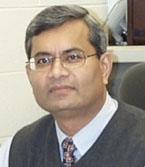
The oldest institute of medical research in Romania presented Bhanu Jena, Ph.D., Wayne State University distinguished professor of Physiology, with the Award of Honorary Scientist.
Dr. Jena, also a professor of Physics and Astronomy, and of Chemical Engineering and Material Sciences, received the honor from the Victor Babes National Institute of Research and Development in Pathology and Biomedical Sciences in Bucharest. He had been invited to give the keynote opening lecture of the institute's 130th anniversary, sponsored by the Romanian National Academy.
His lecture, "Porosome: The Secretory Nanomachine in Cells," detailed the mechanic of the prosome, which he discovered.
"I was pleasantly surprised" to receive the award, said Dr. Jena, who also is director of WSU's NanoBioScience Institute. He received the honor, which reads, "for his creativity and inventiveness invested in the discovery of the porosome, the universal portal for cell secretion," immediately following his presentation.
The porosome is the universal secretory machinery in cells. Secretion is a fundamental cellular process that occurs in all living organisms. Cell secretion is responsible for numerous activities, including neurotransmission and the release of hormones and digestive enzymes. Secretory defects are responsible for a number of debilitating conditions, including growth defects, diabetes and neurological disorders.
Dr. Jena's work has focused on the molecular machinery and mechanism underlying cell secretion. His discovery of the porosome has revolutionized understanding of the secretory process in cells. He and his team have determined the structure and dynamics of the porosome, its isolation and composition, and its functional reconstitution in lipid membrane. His studies demonstrate for the first time that, following a secretory stimulus, membrane-bound secretory vesicles transiently dock and fuse at the base of porosomes present at the cell plasma membrane to release intravesicular contents. The action opposes the commonly held belief that during cell secretion, secretory vesicles completely merge and collapse at the cell plasma membrane.